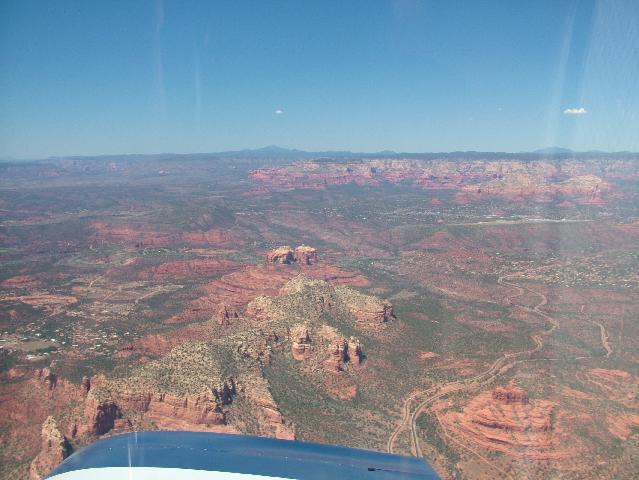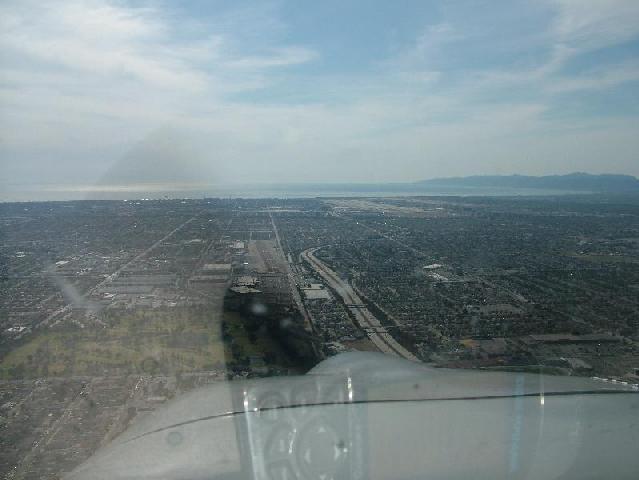Ron Lee
Well Known Member
Planned flight path was 00V - KSEZ - P52 - KBNG - KCMP - KHHR
Altitude 16,500' using flight following. Fuel stop was P52 but that so close to Sedona that I had to check it out

I spotted Banning Pass over 130 nm away but did not know what it was (first time here). Around the time of overflying Banning Pass I was asked for my route and I mentioned BNG to CMP to HHR and that I was new here.
No problems other than having to change frequencies seven or so times before I was handed off to the HHR tower.
This is the view of HHR on final with LAX a few miles to the northwest (above the nose and a bit right). I was to remain above 1500' MSL until I crossed a certain expressway. I was over one that went east-west and asked if that was it. Nope...one ahead. After returning home I checked and the north-south one was 110. May or may not have been the one mentioned.

The trip back was even easier leaving HHR. I was given a frequency where I got Class B clearance and climb to enroute altitude (17,500'). Fuel stop was at St Johns (KSJN) where the fuel was about $2.77 USD a gallon. This is another place I had wanted to visit because of the fuel price. Friendly FBO and landing to take-off was right at 30 minutes.
With preplanning, advice from guys in the California forum and superior piloting, it was not a problem even though I was apprehensive about flying in the LA basin. Another expansion of my flying comfort zone. If I ever go back, it will be much less stressful unless I go on a weekend. I do not like VFR flight corridors and my path did basically use them.
I was asked about my cruising altitudes. The terrain in much of the west is less than hospitable. What may look semi smooth and level from several thousand feet often is not. Altitude gives me options. My groundspeed is typically 155 knots and I burn under seven GPH. I will have to check my consumption over the entire trip to get an average including climb and descent but i will wager that it is still below 7 GPH.
I just checked and assuming no math blunders I averaged 6.8 GPH for the entire trip. That includes climbing to 16,500' twice on the way out and 17,500' twice on the way back (the first one from sea level).
Altitude 16,500' using flight following. Fuel stop was P52 but that so close to Sedona that I had to check it out

I spotted Banning Pass over 130 nm away but did not know what it was (first time here). Around the time of overflying Banning Pass I was asked for my route and I mentioned BNG to CMP to HHR and that I was new here.
No problems other than having to change frequencies seven or so times before I was handed off to the HHR tower.
This is the view of HHR on final with LAX a few miles to the northwest (above the nose and a bit right). I was to remain above 1500' MSL until I crossed a certain expressway. I was over one that went east-west and asked if that was it. Nope...one ahead. After returning home I checked and the north-south one was 110. May or may not have been the one mentioned.

The trip back was even easier leaving HHR. I was given a frequency where I got Class B clearance and climb to enroute altitude (17,500'). Fuel stop was at St Johns (KSJN) where the fuel was about $2.77 USD a gallon. This is another place I had wanted to visit because of the fuel price. Friendly FBO and landing to take-off was right at 30 minutes.
With preplanning, advice from guys in the California forum and superior piloting, it was not a problem even though I was apprehensive about flying in the LA basin. Another expansion of my flying comfort zone. If I ever go back, it will be much less stressful unless I go on a weekend. I do not like VFR flight corridors and my path did basically use them.
I was asked about my cruising altitudes. The terrain in much of the west is less than hospitable. What may look semi smooth and level from several thousand feet often is not. Altitude gives me options. My groundspeed is typically 155 knots and I burn under seven GPH. I will have to check my consumption over the entire trip to get an average including climb and descent but i will wager that it is still below 7 GPH.
I just checked and assuming no math blunders I averaged 6.8 GPH for the entire trip. That includes climbing to 16,500' twice on the way out and 17,500' twice on the way back (the first one from sea level).
Last edited:




